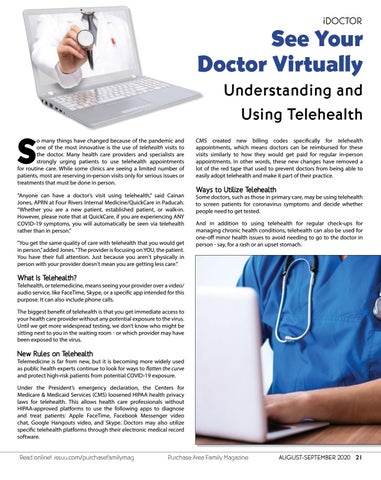iDOCTOR
See Your Doctor Virtually
Understanding and Using Telehealth
S
o many things have changed because of the pandemic and one of the most innovative is the use of telehealth visits to the doctor. Many health care providers and specialists are strongly urging patients to use telehealth appointments for routine care. While some clinics are seeing a limited number of patients, most are reserving in-person visits only for serious issues or treatments that must be done in person.
CMS created new billing codes specifically for telehealth appointments, which means doctors can be reimbursed for these visits similarly to how they would get paid for regular in-person appointments. In other words, these new changes have removed a lot of the red tape that used to prevent doctors from being able to easily adopt telehealth and make it part of their practice.
“Anyone can have a doctor’s visit using telehealth,” said Cainan Jones, APRN at Four Rivers Internal Medicine/QuickCare in Paducah. “Whether you are a new patient, established patient, or walk-in. However, please note that at QuickCare, if you are experiencing ANY COVID-19 symptoms, you will automatically be seen via telehealth rather than in person.”
Some doctors, such as those in primary care, may be using telehealth to screen patients for coronavirus symptoms and decide whether people need to get tested.
"You get the same quality of care with telehealth that you would get in person,” added Jones. “The provider is focusing on YOU, the patient. You have their full attention. Just because you aren't physically in person with your provider doesn't mean you are getting less care."
Ways to Utilize Telehealth
And in addition to using telehealth for regular check-ups for managing chronic health conditions, telehealth can also be used for one-off minor health issues to avoid needing to go to the doctor in person - say, for a rash or an upset stomach.
What Is Telehealth?
Telehealth, or telemedicine, means seeing your provider over a video/ audio service, like FaceTime, Skype, or a specific app intended for this purpose. It can also include phone calls. The biggest benefit of telehealth is that you get immediate access to your health care provider without any potential exposure to the virus. Until we get more widespread testing, we don’t know who might be sitting next to you in the waiting room - or which provider may have been exposed to the virus.
New Rules on Telehealth
Telemedicine is far from new, but it is becoming more widely used as public health experts continue to look for ways to flatten the curve and protect high-risk patients from potential COVID-19 exposure. Under the President’s emergency declaration, the Centers for Medicare & Medicaid Services (CMS) loosened HIPAA health privacy laws for telehealth. This allows health care professionals without HIPAA-approved platforms to use the following apps to diagnose and treat patients: Apple FaceTime, Facebook Messenger video chat, Google Hangouts video, and Skype. Doctors may also utilize specific telehealth platforms through their electronic medical record software.
Read online! issuu.com/purchasefamilymag
Purchase Area Family Magazine
AUGUST-SEPTEMBER 2020 21








